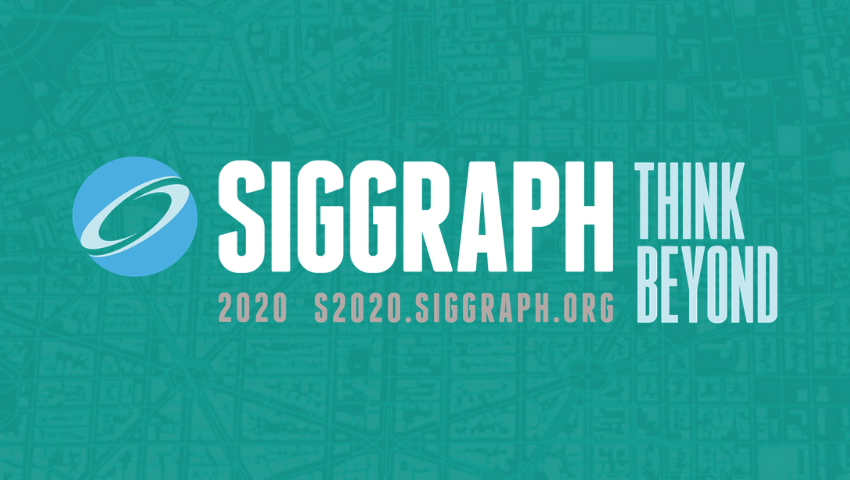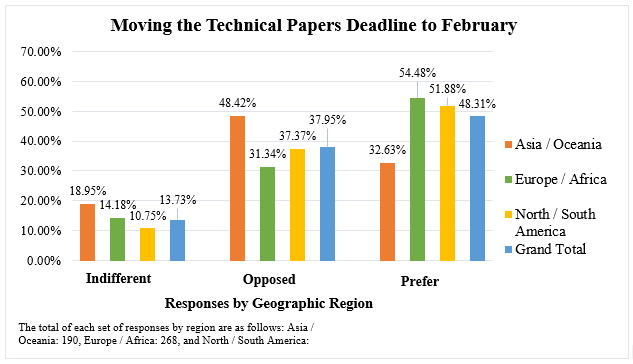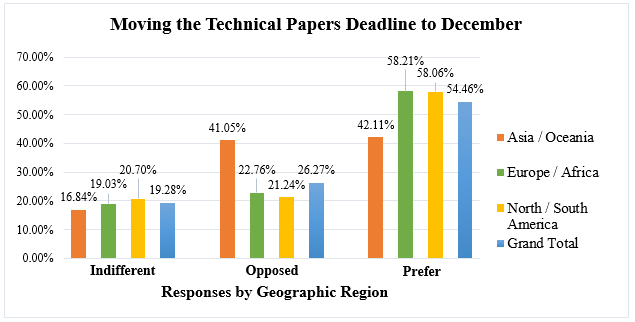A Message from ACM SIGGRAPH President Jessica Hodgins
About a month ago we sent out a survey asking for your thoughts about what the virtual SIGGRAPH 2020 should look like. We sent the survey to the SIGGRAPH 2020 accepted contributors, ACM SIGGRAPH members, and attendees of SIGGRAPH 2019 who had given us permission to contact them after the conference. Over one thousand of you responded with your thoughts about the virtual SIGGRAPH 2020. We are very grateful that you took the time to send us your ideas and opinions. Your passion for SIGGRAPH came through in your thoughtful responses and over fifty pages of free-form answers. We were honored and awed by that expression of support for SIGGRAPH. Many of us on the EC and the conference team have looked at the data and a few of us have read all the comments and summarized them for the others.
Here is a summary of what we learned from the survey. We are also posting the quantitative results of the survey here and the free-form answers here (scrubbed for names and email addresses but otherwise unfiltered).
Beyond the podium-based programs that convert relatively easily to virtual, you suggested that we should focus on taking E-Tech, BOFs, Art Gallery and Posters virtual. All of those programs (as well as others) will be represented in the virtual SIGGRAPH 2020 thanks to the hard work of the Conference Chair, Kristy Pron, and her team of program chairs.
Even though we know that the “meet in the hallway and chat” form of networking won’t be as natural at the virtual SIGGRAPH as it is at an in-person conference, there was strong support for networking activities with topic-based breakouts and the ability to search and connect with other attendees emerging as the top choices. Mentoring also came up repeatedly as something that could be made to work at a virtual conference. Mentoring could be one-on-one via matches based on interests or career path or in small groups for AMA (ask me anything) sessions. Networking opportunities like those might even be better for participants new to the field than what happens in the packed days of an in-person SIGGRAPH. We are still figuring out how best to facilitate networking at the virtual conference but we know that it is important to our community. One advantage to being virtual is that we can have many more BOF sessions so feel free to send in your ideas to that program and set up a meetup on the topic(s) that you are most passionate about.
There was also support for taking more of the content produced by our community to year-round presentations now that we won’t all be converging on one location for five days. Respondents requested both courses on new and emerging areas and on fundamentals that would be offered year round. We are producing a series of lectures on Machine Learning now and we have recently run some panels and talks about how to manage working from home. The most recent of those, by Paul Debevec, is available here. We also plan to run part of the Frontiers program with its focus on new areas adjacent to traditional SIGGRAPH topics before and after the conference.
Some of the survey questions asked directly about how we should run the virtual conference. Respondents were flexible on the start date although they wanted us to avoid the week of GDC. We were pleased to see that as we needed a bit of extra time for planning the virtual conference and pulling together all the material from our hundreds of contributors. As was just announced on https://s2020.siggraph.org the conference will be held from August 24-28th with on-demand content available beginning on August 17th.
Most people were also willing to pay for the virtual SIGGRAPH. We were glad to see that because the registration fees will allow us to cover the costs of the virtual SIGGRAPH and recoup some of the hefty losses from the cancellation charges for the in-person conference. Although by being fiscally conservative over the last decade of successful conferences, we had built up a cushion over ACM’s required bank balance, reducing our losses for 2020 will allow us to more quickly ramp back up our activities in support of the community.
The registration fees for the conference have been announced https://s2020.siggraph.org/attend/register/ and registration will open in not too long. We kept the rate for students and the unemployed low to allow people who normally could not travel to an in-person conference to be able to attend and learn from the content. We added a supporter rate so that those who have the ability can give back to the conference and the organization.
The top choice for presentation format for podium presentations was pre-recorded with live Q&A (an inverted or flipped format) and we are adopting this for most of the relevant programs. This option was most strongly preferred by contributors which was good since they are the ones who will have to put in the extra work to create compelling presentations.
Not surprisingly given the current economic climate, the job fair came up a number of times as being important. SIGGRAPH 2020 will be offering attendees the ability to be a part of the virtual Job Fair and view job listings posted by SIGGRAPH Exhibitors throughout the year. We also plan to provide access to videos and other materials that will help with resume writing, provide ideas and tips for interviewing and more.
As is always the case with a survey like this, we realized after the fact that there were important questions that we failed to ask. We should have had more questions about time zones and how best to cope with them given that not everyone would be physically in the same time zone this year. But both participants and contributors gave us their opinions on this issue in the answers to the free-form questions. We are adopting the suggestions of much shorter days and making much of content available on demand in advance of the “live” part of the conference. This schedule should also allow us to have somewhat fewer parallel sessions than usual which a number of people suggested could be an upside of a virtual conference. The content will continue to be available via your registration credentials for a few months after the conference and then freely available from the organization web site via ACM’s Open TOC program after it has been transferred to the ACM Digital Library.
In closing, I would like to thank you again for the passion that you showed for SIGGRAPH in your thoughtful responses to our survey. It informed our thinking about a number of key decisions as we put together the first ever virtual SIGGRAPH.
All of the content has been selected for SIGGRAPH 2020 now and the trailers that are starting to drop showcase just how amazing the content is. We still have time to implement more events in support of networking/mentoring and we plan to have additional curated events both before and after the conference so if you have suggestions or if you would like to help out, please send me an email at president@siggraph.org.
Jessica Hodgins
President
ACM SIGGRAPH


